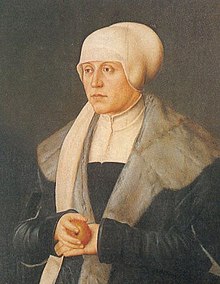Kunigunde of Austria
| Kunigunde of Austria | |
|---|---|
 | |
| Duchess consort of Bavaria-Munich | |
| Tenure | 3 January 1487 – 1 December 1503 |
| Predecessor | Anna of Brunswick-Grubenhagen-Einbeck |
| Duchess consort of Bavaria | |
| Tenure | 1 December 1503 – 18 March 1508 |
| Successor | Marie of Baden-Sponheim |
| Born | 16 March 1465 Wiener Neustadt, Styria |
| Died | 6 August 1520 (aged 55) Püttrich Convent, Munich, Bavaria |
| Spouse | Albert IV, Duke of Bavaria |
| Issue | Sidonie of Bavaria Sibylle, Electress Palatine Sabina, Duchess of Württemberg William IV, Duke of Bavaria Louis X, Duke of Bavaria Ernest, Archbishop in Salzburg Susanna, Margravine of Bayreuth and Countess Palatine of Neuburg |
| House | Habsburg (by birth) Wittelsbach (by marriage) |
| Father | Frederick III, Holy Roman Emperor |
| Mother | Eleanor of Portugal |
| Religion | Roman Catholicism |
Kunigunde of Austria (German: Kunigunde von Österreich; 16 March 1465 – 6 August 1520), a member of the House of Habsburg, was Duchess of Bavaria from 1487 to 1508, by her marriage to the Wittelsbach duke Albert IV.
Biography
Early life
Kunigunde was born in Wiener Neustadt, the fourth of five children to Emperor Frederick III and his wife Eleanor, daughter of King Edward of Portugal. However, only she and her elder brother Maximilian survived to adulthood.[1][2] She was raised in Wiener Neustadt and at the Inner Austrian court in Graz, Styria, where she grew up in an informal and open atmosphere, without rigid court etiquette. Contrary to former practice, she learned not only to read, write, and embroider, but also received instruction in riding and hunting, astronomy and mathematics.[3]
Kunigunde's family had left the Imperial residence at the Hofburg in Vienna after lengthy quarrels with Frederick's younger brother Archduke Albert VI of Austria. Though Albert had unexpectedly died in 1463 and the emperor proclaimed a general Landfrieden peace, armed hostilities in the Austrian lands continued.
Like most daughters of royal families, since her early years Kunigunde was involved in the political intrigues of her time. In 1470 the Hungarian king Matthias Corvinus requested her hand; however, Emperor Frederick, a rival for the Crown of Saint Stephen and also for the Lands of the Bohemian Crown, refused him. As her mother had died in 1467, Kunigunde made her formal presentation at the side of her father at the age of fifteen, in 1480, during the visit of Duke George of Bavaria, called "the Rich", to Frederick's court in Vienna. George was solemnly enfeoffed with the Imperial estate of Bavaria-Landshut and after the celebrations Kunigunde was sent to Burggraf Ulrich III von Graben to Graz for her safety; however, after a plot against the emperor was discovered, he moved to Linz and sent Kunigunde to the Tyrolean court in Innsbruck with Archduke Sigismund of Austria, Frederick's first cousin and former guardian.
Duchess of Bavaria-Munich

In Innsbruck Kunigunde met Duke George's cousin, Albert IV, then ruler of Bavaria-Munich and about 18 years her senior, whom she married on 2 January 1487. Her father had initially given his consent, however, when Albert's forces occupied the Imperial City of Regensburg, he changed his mind. The couple wed at the Innsbruck Hofburg residence, against the will of Kunigunde's father. Her brother Maximilian mediated between her and Emperor Frederick; he was able to prevent an Imperial ban.
Kunigunde followed her husband to Bavaria and served as joint regent for their eldest son William IV, born in 1493. In spite of her resignation from the Imperial court, she tried to influence the politics of the state as she acted in favour of the rights of her younger sons. She stayed in close contact with her brother, Emperor Maximilian I, and with other rulers and relatives in Europe.
After the death of Albert in 1508 she later joined the Convent of Püttrich which she favoured and lived there until her death in 1520.
Issue
With Duke Albert IV of Bavaria she had seven children:
- Sidonie (1 May 1488 – 27 March 1505). Betrothed to Louis V, Elector Palatine, she died before the wedding took place.
- Sibylle (16 June 1489 – 18 April 1519), married in 1511 to Louis V, Elector Palatine.
- Sabina (24 April 1492 – 30 April 1564), married in 1511 to Duke Ulrich I of Württemberg.
- William IV, Duke of Bavaria (13 November 1493 – 7 March 1550).
- Louis X, Duke of Bavaria (18 September 1495 – 22 April 1545).
- Ernest (13 June 1500 – 7 December 1560), an ecclesiastical official in Passau (1517–40), Archbishop in Salzburg (1540–54) and Eichstädt.
- Susanna (2 April 1502 – 23 April 1543), married firstly in 1518 to Margrave Casimir of Brandenburg and secondly in 1529 to Otto Henry, Count Palatine of Neuburg, since 1556 Elector Palatine.
Ancestry
| Ancestors of Kunigunde of Austria |
|---|
References
- ^ Marek, Miroslav. "Complete Genealogy of the House of Habsburg". Genealogy.EU.[self-published source][better source needed]
- ^ Template:MLCC
- ^ Sigrid-Maria Größing: Um Krone und Liebe. Amalthea Verlag.
